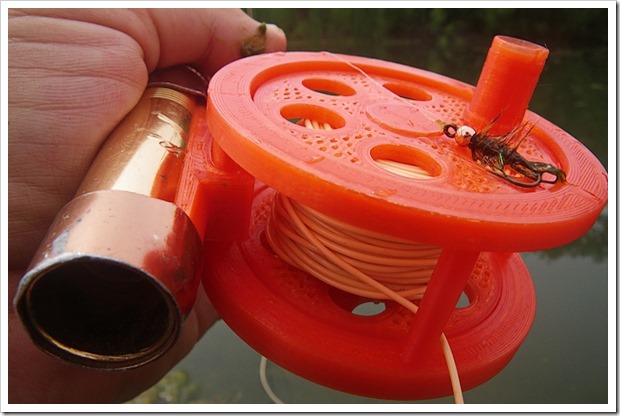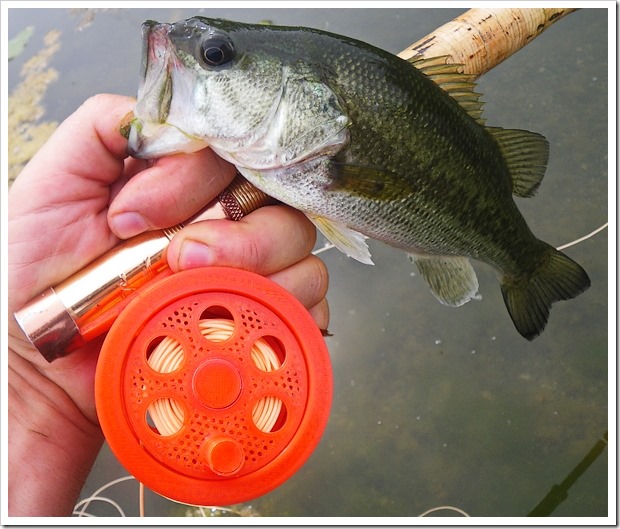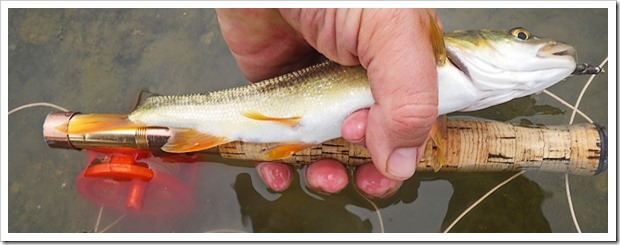It positioned me on the fringe of acceptable, but I’ve always felt comfortable there given my insistence that a hobby should cost less than a 30 year mortgage. A twenty-nine dollar fly rod and my prized, eleven dollar “Red Rocket” reel made my ensemble cost less than fifty bucks … and at that price most of the “debutants” I was rubbing shoulders with were shunning me for not propping up my portion of the economy.
… but not before asking what fly I was using to land all them fish, naturally.
The reel was a trifle exorbitant, given that I had to buy six feet of extrudable nylon to use for the venerable “click-pawl”mechanism, and the postage from Amazon was another five, so the reel was ninety seven cents worth of powdered corn husks and six bucks worth of nylon scrim.

As I’d always stocked my vest with non perishables should a misstep leave me stranded on a trail somewhere, knowing the reel was once plant proteins and equivalent to a Wonka Everlasting Gobstopper, I knew a broken leg meant while awaiting rescue I could gnaw on the spool for precious proteins.
Calories not withstanding, us candy-assed “technological fishermen”, with our fixation on precision engineering and expensive materials from aerospace and the military, have never really thought through the physics of what we do and the cost benefit of what we carry.
Tenkara-style fishing has adequately demonstrated a reel isn’t critical to fly fishing. For eighty percent of us, our quarry is a nine inch, pen raised, pellet eating, softie – not likely to peel line for a city block or give us more than a few head shakes before we stomp life out of it.
It shouldn’t be overly surprising that hot plastic shat via computer nozzle can construct complex shapes whose tolerances make a simple storage device with a classic drag. “Ruby Red” and “Lemon Yellow”, won’t earn any envious glances from the parking lot throng, and may even draw a few snickers, but parking lot loyalties have always shifted to whomever is catching fish, despite their initial fixation with form and fashion.

One of the fellows from work had printed out a prototype using Eclectic Angler’s plans, and while fluorescent green PLA was a bit hard on the eyes, the action on the reel was sound. The prototype is about the size of an LRH Lightweight (or Medalist 1494 1/2) and can hold 50-75 yards of backing and a WF-5F.
I was quite pleased with the reel and its simplicity. While reel companies fuss over titanium and composites it’s nice to return to the bare essentials – if for no other reason than to understand how tackle has evolved into software; new features added without thought for the quarry, the physics, or the ROI.
Considering 3D printers are flirting with the $400 price tag already, this capability is likely to be mainstream fairly soon. While the 3D reel is not likely to replace your existing trove of tackle, I would think it a great way to introduce your kids to fishing. An old rod coupled with a new technology yielding a flashy reel may stimulate your kid into giving Dad’s pastime a try – perhaps even making a life long impression.
Where these will really shine is the casting club’s twice yearly casting classes. Marry these with a couple dozen Chinese manufactured double tapers from eBay, and you can teach the public without fear of theft or breakage.


Thanks for the post about my 3D printed reels. I’m working on a few new designs including a small ultralight reel.
Cheers,
Michael
These are great little reels. “Plastic” has its aversions, but if you’ve the courage to trust the reel and ignore the more expensive and fashionable gear, it’s a great little tool.
Mike got me started on making and tinkering with reels! He did surprise me with his 3D printed reels, however. I’m impressed.
I love knowing that there are other folks out there crafting wonderful things by hand, or modifying existing tools and such to personalize them and improve them.
Even prooving that something can be done!
It tells me that craftsmanship isn’t dead. And, that some people would still like to have one loved, well usable tool rather than just collecting STUFF.
That it’s worth trying something because, maybe, one can.
Thanks kbarton10.
And thank you John! Looking forward to seeing you again this fall!
One little note – I’ve now started using a short section of a nylon zip tie instead of the Nylon rod. These can be found almost everywhere for free (they are commonly used for product packaging, etc) or you can purchase a pack of 10 at your local hardware store for a couple of bucks. They are flat so you have to trim one end so it fits in the little hole for the check pawl. I am working on an updated backplate that has a small rectangular hole for the zip tie.
cheers,
Michael